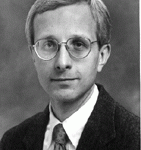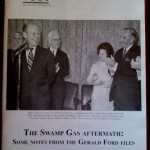
1. Mr Rodeghier, could you please introduce the CUFOS, its set-up and objectives? Is the center working in collaboration with others American or foreign Ufological organisations?
CUFOS was begun in late 1973 by Dr. J. Allen Hynek, a professor of astronomy atNorthwesternUniversityand the long-time principal scientific advisor to the US Air Force project on UFOs (Blue Book). It is a not-for-profit organization that was envisioned by Hynek as a type of scientific clearinghouse and think tank for the UFO subject. The objectives and goals of the organization have evolved over time, but the most important are to be a reliable source of information on the UFO phenomenon, to do our own research on a small number of focused projects, and assist other individuals and organisations to do investigations and research that are rigorous and well designed. We have a small but select scientific board of collaborators, both in the States and abroad.
CUFOS has formal ties with the Mutual UFO Network (MUFON) and the Fund for UFO Research (FUFOR) through the UFO Coalition, a partnership that has completed a number of joint projects, such as the Abduction Monitoring study, or the publication of specialized monographs.
2. What is your function within the CUFOS? Could you please describe some of your activities?
CUFOS is not a large organization, and no one is paid a salary, so my duties range from the mundane to the more scientifically interesting. My chief tasks are to coordinate our investigative and research activities, to correspond and network with our collaborators, and to help organize and maintain the CUFOS archives. From time to time I also deliver lectures or appear on radio or television programs as a spokesman for CUFOS.
3. You have been involved since some decades in the UFO research. From your perspective, how has the overall topic evolved since Mr Hynek’s period?
Many years ago, the UFO problem seemed more simple and straightforward. If there are unknown UFOs in our skies, then they will undoubtedly be aliens from somewhere nearby in the cosmos. This was before abduction reports, before more bizarre cases were well known, and before the phenomenon continued to evolve in its characteristics (see below). Now the puzzle of UFOs has only deepened, although even Hynek before his death had realized that something even more unusual or esoteric than alien visitors might be involved, at least in part (an idea that researchers such as Jacques Vallee had proposed for many years).
4. How can you explain the fact that since 60 years nobody has been able to be “lucky” in terms of finding “any” scientifically acceptable evidence? Is it just due to a lack of allocating the necessary resources?
It is actually not surprising that we have made little progress in understanding or learning more about the UFO phenomenon since it first appeared with great publicity in 1947. The sociology of science, both in its traditional Mertonian forms and in the more modern “strong program” would have predicted this. To study anything scientifically requires resources, and this is especially true for a phenomenon that appears sporadically and whose appearance seems to follow no predictable pattern. This has made it impossible except in rare circumstances (e.g., at Hessdalen orYakimaValleyinWashingtonState) to obtain data about UFOs in real-time. This has left us with almost exclusively witness testimony as data, which has been sufficient to establish the existence and general mystery of UFOs, but has not provided enough data to go beyond simple searches for patterns. There have certainly been a few cases with some intriguing physical evidence, such as Delphos, Kansas, or the Amaranth case investigated by the French government UFO project (GEPAN, now GEIPAN), but these events don’t provide any insight into the fundamental nature of the UFO phenomenon.
As comparison, think about the lack of progress in explaining how ball lightning is generated. The study of ball lightning, while not well funded, has attracted the attention of a small number of atmospheric physicists and other scientists, and while there are many theories, there are no definitive answers. And the study of ball lightning predates serious UFO studies by many years.
Given that ufology has always operated at the margins of society, with no institutional funding, no support in the universities, and with active hostility from most elements of the established sectors of society, it is perfectly understandable that a phenomenon on which experiments can’t easily be done and that appears for only a brief duration would have so little physical evidence. (I certainly believe there is enough “soft” evidence from witness testimony to make a strong case for the reality of the UFO phenomenon.)
5. If so, what could be done according to you to remedy this?
I am hopeful that new technologies will make it easier to create networks of stations that can observe UFOs as they appear. We urgently need to acquire spectroscopic data about UFOs which will immediately provide some clues about their origin. And I am hopeful that the public can become involved in these efforts, as amateur astronomers have and continue to assist professional astronomers in many research projects.
I am not so naïve as to suppose that new, significant sources of funding will soon be available, so I expect that progress will continue to be quite slow. We must try to be more clever with the resources we have.
6. What is your(s) personal hypothesis concerning the nature of the UFO phenomena? Is Ufology a serious subject?
I have remained firmly agnostic about the ultimate origins of the UFO phenomenon, for several reasons. First, we don’t know enough or have appropriate data collection methods in place to test the various hypotheses that have been suggested. Ufology is a serious subject, but it is barely a proto-science. We are still at the stage of Tycho Brahe collecting observations which Johannes Kepler could then later use to develop his laws of planetary motion.
I do expect that there is more than one phenomenon involved in the unknown UFO cases. Some of these are probably caused by currently unrecognized natural phenomena (balls of light cases fall into this category), some may be caused by elements of the human mind and psychology (some encounter cases fall into this category), and others may well be caused by a non-human intelligence (daylight disk and other cases of the “nuts and bolts” type fall into this category).

7. Are you a SETI supporter? Do you think that we should intentionally transmit messages across the cosmos?
I definitely believe it is worthwhile to listen and search for signs of ETI, and I’m pleased that SETI has broadened its efforts to search for optical signals and other forms besides radio waves. Some SETI investigators have even argued that we should search for alien probes in the solar system or evidence of ancient alien activity on Earth (see http://www.iar-conicet.gov.ar/SETI/Tough-Lemarchand.pdf for one example). I am waiting for the SETI community to recognize that such ideas are also compatible with current visits of alien probes to Earth, which could thus be one cause of UFO sightings. This isn’t much of a logical leap, but it is one that they refuse to take.
As for broadcasting messages, I’m not concerned about any danger to us from such intentional signals, but I also don’t believe there is a good rationale for doing so now. Or, if we are going to send signals, it should be done systematically, not in sporadic efforts as has been done beforehand.
8. The abduction topic is very marginal in Europe compared to the U.S.A. What do you think about that?
Abductions have indeed been studied and taken much more seriously in the U. S., but that has also been true of UFO crashes and other more exotic topics in the UFO field. American ufologists have generally been more oriented toward the idea that some UFOs could be extraterrestrial craft, and it is actually a small leap from there to believe that alien beings might want to abduct some humans for testing. Abductions have also been taken more seriously in Australia, and certainly so in South America, so the split on abductions is more on the lines of Europe compared to the rest of the world, rather than Europe compared to the U.S. In recent years, though, there has been a division among serious ufologists here in the States, with some continuing to believe that abductions are real events, basically as reported by the witnesses, while others have become more sceptical, or at least more cautious in viewing the data. I tend to be in the second group, although there are certainly a few very intriguing abduction cases, such as Buff Ledge in Vermont, that argue for the reality of at least the core experience.
The majority of those who report abductions are sincere, but I believe they have had various types of experiences or events that have explanations other than aliens abducting them from their homes or vehicles. These include sleep paralysis, odd dreams, and dissociative states. But there remains a residue of data that defies easy explanation. European ufologists have tended to focus on these other explanations and, perhaps rightly, have also shunned the use of hypnosis for memory recovery in abduction cases.
9. If you would have to list your own 5 best UFO sightings, which cases would be featured?
My list of “best” UFO cases depends somewhat on whether the list is of physical trace cases, or cases with instrumented data, or just solid, reliable cases with competent observers, etc. It also changes over the years as new cases occur or old ones are re-investigated. To name a few, the Mansfield, Ohio case of 1973 (the Coyne sighting), where a National Guard helicopter was affected by a UFO, Loch Raven Dam, Maryland, where the vehicle of two witnesses was affected by a UFO, and they suffered physiological effects, Socorro, New Mexico in 1964, where a policeman saw a UFO at close range, along with two humanoid figures, and traces were left by the UFO, the Clyde Tombaugh sighting from 1949 of odd green rectangles moving across the sky, and the RB-47 radar case from 1957 where an Air Force plane with sophisticated equipment tracked UFOs, along with ground radar.
I could easily name many other cases, but these five provide a range of case types and UFO effects. You will note that they are all from many years ago. Although there are certainly interesting cases that occur now, some of the most intriguing and well-investigated cases happened in the first half of the modern era of UFO sightings.
10. There seems to be since several years an important reduction of good/strange UFO cases inEurope. Is it also what you observe in theU.S.A.?
There are some “facts” about UFOs that are well-established, even if they don’t help us unravel the mystery of the subject. One of these facts is that after an upsurge in sightings in the late 1970s, UFO reports declined, worldwide, for many years until the 1990s, but even then have been at lower numbers compared to the 1950 to late 1970s period. This is true despite the fact that there are more potential observers, as population has continued to increase everywhere, and there are more ready means of reporting, including the internet. Even more significant is the reduction in cases involving potential physical evidence (Close Encounters of the Second Kind) and cases where a creature or humanoid is seen in conjunction with a UFO (Close Encounters of the Third Kind). This type of close encounter has almost vanished even though there were hundreds of such reports in the early years.
Another significant change has been in the number of daylight sightings, which have decreased from about one-third years ago to just a few percent today. And finally, UFOs are much more commonly reported to be triangular or boomerang-shaped now, rather than the common disc that is the image of a UFO in the popular mind. What to make of these changes, and whether they are truly fundamental to the phenomenon, is another puzzle.
11. With the tendency of more administrative openness and transparency, do you expect more official American UFO archives to be released in the next years? Are there still attempts to locate UFO related information?
There are continuing attempts to locate more official documents that are concerned with UFOs, such as by John Greenwald at his The Black Vault project (www.theblackvault.com/), but we face diminishing returns. I don’t believe that there is some large cache of documents waiting to be discovered at any agency or organization (with the possible exception of the US Navy), and even then, these documents will be of more historical than scientific interest. Furthermore, if there has been, or is now, a truly super-secret study of UFOs being conducted by a government group, those files will never be accessed via archival searches and FOIA requests.

12. Have you read Ms. Leslie Kean’s UFO book? What is your opinion?
Kean’s book is a first-rate attempt to make a case that UFOs deserve scientific study, and that some UFO reports are of potential military and government interest. She did not try to search out new sightings and data, but instead, as a working journalist who has become convinced of the reality of UFOs, attempted to present a cogent and compelling case using some of the best evidence. Whether or not the book will succeed in gaining the attention and support of scientists, the media, and governments is a different matter, but I appreciate her effort.
13. Given the difficulties of studying the UFO subject, why do you and your colleagues stay in this vexing field?
Scientists and professionals need a strong motivation to remain in the field, given the many obstacles and frustrations. First, actually witnessing a UFO, especially one that is nearby or is very anomalous, is often personally convincing that there is something of substance to the UFO phenomenon. Second, the idea that some UFOs could be extraterrestrial craft, with all the potential fantastic implications for science and society that involves, drives people to conduct research because they consider this to be perhaps the leading scientific problem of our era. Whatever one’s reasons for studying UFOs, an investigator must possess a great tolerance for ambiguity, uncertainty, and frustration because otherwise they would leave the field for other subjects.
Of course, anyone who studies UFOs has a “real” career in some other discipline which always takes as much, or more, time as can be devoted to UFO studies. And one’s normal career often eventually take precedence and leads people to leave ufology, especially when it is clear there is no funding for UFO studies.
14. What are your personal and CUFOS future plans?
Personally, I continue to be interested in looking for patterns in the UFO data, especially using data mining techniques as well as more standard methods. This type of research is made more difficult because the quality of data on UFO sightings is admittedly rather low, but I still believe that there are relationships in the data, and with external variables, that may be fruitful. I also am working on projects to gather physical evidence which we hope to fund through the public and its interest in the subject. At CUFOS we hope to scan our complete collection of UFO reports—over 50,000 sightings—and make them available on the web.
Many thanks Mr Rodeghier for your time and all the best luck for your future UFO researches….
 Based in Chicago, the Center for UFO Studies (CUFOS – www.cufos.org) is an international group of scientists, academics, investigators, and volunteers dedicated to the continuing examination and analysis of the UFO phenomenon. The organisation publishes since 1976 the International UFO Reporter (IUR), a publication that most observers consider as the leading English-language UFO journal. The CUFOS purpose is to promote serious scientific interest in UFOs and to serve as an archive for reports, documents, and publications about the UFO phenomenon.
Based in Chicago, the Center for UFO Studies (CUFOS – www.cufos.org) is an international group of scientists, academics, investigators, and volunteers dedicated to the continuing examination and analysis of the UFO phenomenon. The organisation publishes since 1976 the International UFO Reporter (IUR), a publication that most observers consider as the leading English-language UFO journal. The CUFOS purpose is to promote serious scientific interest in UFOs and to serve as an archive for reports, documents, and publications about the UFO phenomenon.

